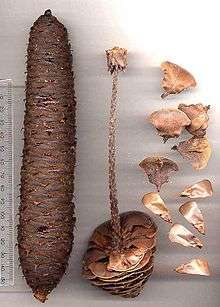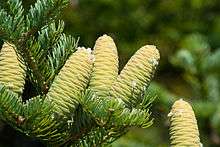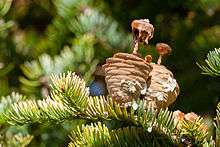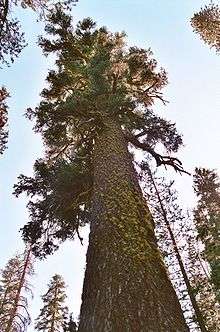Fir
Firs (Abies) are a genus of 48–56 species of evergreen coniferous trees in the family Pinaceae. They are found through much of North and Central America, Europe, Asia, and North Africa, occurring in mountains over most of the range. Firs are most closely related to the genus Cedrus (cedar). Douglas firs are not true firs, being of the genus Pseudotsuga.
| Fir | |
|---|---|
| Korean fir (Abies koreana) cones and foliage | |
| Scientific classification | |
| Kingdom: | Plantae |
| Clade: | Tracheophytes |
| Division: | Pinophyta |
| Class: | Pinopsida |
| Order: | Pinales |
| Family: | Pinaceae |
| Subfamily: | Abietoideae |
| Genus: | Abies Mill. |
| Species | |
|
See text | |
They are large trees, reaching heights of 10–80 m (33–262 ft) tall with trunk diameters of 0.5–4 m (1 ft 8 in–13 ft 1 in) when mature. Firs can be distinguished from other members of the pine family by the way in which their needle-like leaves are attached singly to the branches with a base resembling a suction cup, and by their cones, which, like those of true cedars (Cedrus), stand upright on the branches like candles and disintegrate at maturity.
Identification of the different species is based on the size and arrangement of the leaves, the size and shape of the cones, and whether the bract scales of the cones are long and exserted, or short and hidden inside the cone.
Leaves

 A. grandis foliage – upper side of the leaves
A. grandis foliage – upper side of the leaves
Firs can be distinguished from other members of the pine family by the unique attachment of their needle-like leaves to the twig by a base that resembles a small suction cup.
The leaves are significantly flattened, sometimes even looking like they are pressed, as in A. sibirica.
The leaves have two whitish lines on the bottom, each of which is formed by wax-covered stomatal bands. In most species, the upper surface of the leaves is uniformly green and shiny, without stomata or with a few on the tip, visible as whitish spots. Other species have the upper surface of leaves dull, gray-green or bluish-gray to silvery (glaucous), coated by wax with variable number of stomatal bands, and not always continuous. An example species with shiny green leaves is A. alba, and an example species with dull waxy leaves is A. concolor.
The tips of leaves are usually more or less notched (as in A. firma), but sometimes rounded or dull (as in A. concolor, A. magnifica) or sharp and prickly (as in A. bracteata, A. cephalonica, A. holophylla). The leaves of young plants are usually sharper.
The way they spread from the shoot is very diverse, only in some species comb-shaped, with the leaves arranged on two sides, flat (A. alba) [2]
Cones
 Intact and disintegrated Bulgarian fir cones
Intact and disintegrated Bulgarian fir cones Immature cones of some of species or races are green, not purple-bluish: for instance, Manchurian fir.
Immature cones of some of species or races are green, not purple-bluish: for instance, Manchurian fir. Disintegrating cones of Manchurian fir
Disintegrating cones of Manchurian fir
Firs differ from other conifers in having erect, cylindrical cones 5–25 cm (2–10 in) long that disintegrate at maturity to release the winged seeds.
In contrast to spruces, even large fir cones do not hang, but are raised like candles.
Mature cones are usually brown, young in summer can be green, for example:
or purple and blue, sometimes very dark:
- A. fraseri, A. homolepis (var. umbellata green), A. koreana ('Flava' green), A. lasiocarpa, A. nephrolepis (f. chlorocarpa green), A. sibirica, A. veitchii (var. olivacea green).[2]
Classification
Section Abies
Section Abies is found in central, south, and eastern Europe and Asia Minor.
- Abies alba – silver fir
- Abies nebrodensis – Sicilian fir
- Abies borisii-regis – Bulgarian fir
- Abies cephalonica – Greek fir
- Abies nordmanniana – Nordmann fir or Caucasian fir
- Abies nordmanniana subsp. equi – trojani – Kazdağı fir, Turkish fir
- Abies nordmanniana subsp. bornmülleriana – Uludağ fir
- Abies pinsapo – Spanish fir
- Abies pinsapo var. marocana – Moroccan fir
- Abies numidica – Algerian fir
- Abies cilicica – Syrian fir
Section Balsamea
Section Balsamea is found in northern Asia and North America, and high mountains further south.
- Abies fraseri – Fraser fir
- Abies balsamea – balsam fir
- Abies balsamea var. phanerolepis – bracted balsam fir
- Abies lasiocarpa – subalpine fir
- Abies lasiocarpa var. arizonica – corkbark fir
- Abies lasiocarpa var. bifolia – Rocky Mountains subalpine fir
- Abies sibirica – Siberian fir
- Abies sibirica var. semenovii
- Abies sachalinensis – Sakhalin fir
- Abies koreana – Korean fir
- Abies nephrolepis – Khinghan fir
- Abies veitchii – Veitch's fir
- Abies veitchii var. sikokiana – Shikoku fir
Section Grandis
Section Grandis is found in western North America to Mexico, Guatemala, Honduras and El Salvador, in lowlands in the north, moderate altitudes in south.
- Abies grandis – grand fir or giant fir
- Abies grandis var. grandis – Coast grand fir
- Abies grandis var. idahoensis – interior grand fir
- Abies concolor – white fir
- Abies concolor subsp. concolor – Rocky Mountain white fir or Colorado white fir
- Abies concolor subsp. lowiana – Low's white fir or Sierra Nevada white fir
- Abies durangensis – Durango fir
- Abies durangensis var. coahuilensis – Coahuila fir
- Abies flinckii – Jalisco fir
- Abies guatemalensis – Guatemalan fir
- Abies guatemalensis var. guatemalensis
- Abies guatemalensis var. jaliscana
- Abies vejarii
Section Momi
Section Momi is found in east and central Asia and the Himalaya, generally at low to moderate altitudes.
- Abies kawakamii – Taiwan fir
- Abies homolepis – Nikko fir
- Abies recurvata – Min fir
- Abies recurvata var. ernestii – Min fir
- Abies firma – Momi fir
- Abies beshanzuensis – Baishanzu fir
- Abies holophylla – Manchurian fir
- Abies chensiensis – Shensi fir
- Abies chensiensis subsp. salouenensis – Salween fir
- Abies pindrow – Pindrow fir
- Abies ziyuanensis – Ziyuan fir
Section Amabilis
Section Amabilis is found in the Pacific Coast mountains in North America and Japan, in high rainfall areas.
- Abies amabilis – Pacific silver fir
- Abies mariesii – Maries' fir
Section Pseudopicea

Section Pseudopicea is found in the Sino – Himalayan mountains at high altitudes.
- Abies delavayi – Delavay's fir
- Abies delavayi var. nukiangensis
- Abies delavayi var. motuoensis
- Abies delavayi subsp. fansipanensis
- Abies fabri – Faber's fir
- Abies fabri subsp. minensis
- Abies forrestii – Forrest's fir
- Abies densa – Bhutan fir
- Abies spectabilis – East Himalayan fir
- Abies fargesii – Farges' fir
- Abies fanjingshanensis – Fanjingshan fir
- Abies yuanbaoshanensis – Yuanbaoshan fir
- Abies squamata – flaky fir
Section Oiamel
Section Oiamel is found in central Mexico at high altitudes.
- Abies religiosa – sacred fir
- Abies hickelii – Hickel's fir
- Abies hickelii var. oaxacana – Oaxaca fir
Section Nobilis

Section Nobilis (western U.S., high altitudes)
- Abies procera – noble fir
- Abies magnifica – red fir
- Abies magnifica var. shastensis – Shasta red fir
Uses and ecology
Wood of most firs is considered unsuitable for general timber use and is often used as pulp or for the manufacture of plywood and rough timber. Because this genus has no insect or decay resistance qualities after logging, it is generally recommended in construction purposes for indoor use only (e.g. indoor drywall on framing). Fir wood left outside cannot be expected to last more than 12 to 18 months, depending on the type of climate it is exposed to.
Nordmann fir, noble fir, Fraser fir and balsam fir are popular Christmas trees, generally considered to be the best for this purpose, with aromatic foliage that does not shed many needles on drying out. Many are also decorative garden trees, notably Korean fir and Fraser fir, which produce brightly coloured cones even when very young, still only 1–2 m (3.3–6.6 ft) tall. Other firs can grow anywhere between 30 and 236 feet (9.1 and 71.9 m) tall. Fir Tree Appreciation Day is June 18.
Abies religiosa—sacred fir, is the overwinter host for the monarch butterfly (Danaus plexippus). This insect species migrates from central and north United States and south Canada to Central Mexico (Michoacán and Estado de Mexico). During the fall migration, monarchs cover thousands of miles, with a corresponding multi-generational return north. The western North American population of monarchs west of the Rocky Mountains often migrates to sites in southern California but has been found in overwintering Mexican sites as well.[3] [4]
Firs are used as food plants by the caterpillars of some Lepidoptera species, including Chionodes abella (recorded on white fir), autumnal moth, conifer swift (a pest of balsam fir), the engrailed, grey pug, mottled umber, pine beauty and the tortrix moths Cydia illutana (whose caterpillars are recorded to feed on European silver fir cone scales) and C. duplicana (on European silver fir bark around injuries or canker).
Abies spectabilis or Talispatra is used in Ayurveda as an antitussive (cough suppressant) drug.[5][6]
References
- Schorn, Howard; Wehr, Wesley (1986). "Abies milleri, sp. nov., from the Middle Eocene Klondike Mountain Formation, Republic, Ferry County, Washington". Burke Museum Contributions in Anthropology and Natural History. 1: 1–7.
- Seneta, Włodzimierz (1981). Drzewa i krzewy iglaste (Coniferous trees and shrubs) (in Polish) (1st ed.). Warsaw: Państwowe Wydawnictwo Naukowe (PWN). ISBN 978-83-01-01663-0.
- Groth, Jacob (10 November 2000). "Monarch Migration Study". Swallowtail Farms. Retrieved 21 July 2014.
- "Monarch Migration". Monarch Joint Venture. 2013.
- Schar, Douglas (2015). "Douglas Fir, Pseudotsuga menziesii". Archives. Doctor Schar. Retrieved 2015-10-04.
- Kershaw, Linda (2000). Edible and Medicinal Plants of the Rockies. Edmonton, AB: Lone Pine Publishing. p. 26. ISBN 978-1-55105-229-8.
Bibliography
Philips, Roger. Trees of North America and Europe, Random House, Inc., New York ISBN 0-394-50259-0, 1979.
External links
| Wikimedia Commons has media related to Abies. |
- Abies at The Gymnosperm Database
- Michael P. FRANKIS CONE COLLECTION: Abies at the Arboretum de Villardebelle—images of cones of selected species
- Platt, Karen "Gold Fever" provides descriptions of golden or yellow-leaved Abies cultivars